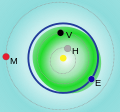| Discovery [1] | |
|---|---|
| Discovered by | Lowell Observatory-LONEOS |
| Discovery site | Anderson Mesa Station, near Flagstaff, Arizona |
| Discovery date | October 17, 2007 |
| Designations | |
| 2007 UW1 | |
| MPO 279093 | |
Aten  NEO | |
| Orbital characteristics [2] | |
| Epoch 21 November 2025 (JD 2461000.5) | |
| Uncertainty parameter 1 | |
| Observation arc | 2239 days 6.13 yr |
| Aphelion | 1.01712759 AU (152.160122 Gm) |
| Perihelion | 0.79768780 AU (119.332396 Gm) |
| 0.90740769 AU (135.746258 Gm) | |
| Eccentricity | 0.1209158 |
| 0.86 yr (315.7 d) | |
Average orbital speed | 31.147779 km/s |
| 196.02469° | |
| 1.1402508°/day | |
| Inclination | 8.215966° |
| 25.921307° | |
| 146.57824° | |
| Earth MOID | 0.0015674 AU (234,480 km) |
| Jupiter MOID | 3.94546 AU (590.232 Gm) |
| Physical characteristics | |
| Dimensions | 80–180 m [3] |
| 22.7 [2] | |
2007 UW1 is a sub-kilometer asteroid that is a near-Earth object of the Aten group.
Contents
| Asteroid | Date | Nominal approach distance (LD) | Min. distance (LD) | Max. distance (LD) | Absolute magnitude (H) | Size (meters) |
|---|---|---|---|---|---|---|
| (152680) 1998 KJ9 | 1914-12-31 | 0.606 | 0.604 | 0.608 | 19.4 | 279–900 |
| (458732) 2011 MD5 | 1918-09-17 | 0.911 | 0.909 | 0.913 | 17.9 | 556–1795 |
| (163132) 2002 CU11 | 1925-08-30 | 0.903 | 0.901 | 0.905 | 18.5 | 443–477 |
| 2002 JE9 | 1971-04-11 | 0.616 | 0.587 | 0.651 | 21.2 | 122–393 |
| 2013 UG1 | 1976-10-17 | 0.854 | 0.853 | 0.855 | 22.3 | 73–237 |
| 2012 TY52 | 1981-11-04 | 0.818 | 0.813 | 0.823 | 21.4 | 111–358 |
| 2017 VW13 | 2001-11-08 | 0.454 | 0.318 | 3.436 | 20.7 | 153–494 |
| (308635) 2005 YU55 | 2011-11-08 | 0.845 | 0.845 | 0.845 | 21.9 | 320–400 |
| 2018 AH | 2018-01-02 | 0.773 | 0.772 | 0.773 | 22.5 | 67–216 |
| (153814) 2001 WN5 | 2028-06-26 | 0.647 | 0.647 | 0.647 | 18.2 | 921–943 |
| 99942 Apophis | 2029-04-13 | 0.0981 | 0.0963 | 0.1000 | 19.7 | 310–340 |
| 2015 XJ351 | 2047-06-06 | 0.789 | 0.251 | 38.135 | 22.4 | 70–226 |
| 2005 WY55 | 2065-05-28 | 0.865 | 0.856 | 0.874 | 20.7 | 153–494 |
| (308635) 2005 YU55 | 2075-11-08 | 0.592 | 0.499 | 0.752 | 21.9 | 320–400 |
| (456938) 2007 YV56 | 2101-01-02 | 0.621 | 0.615 | 0.628 | 21.0 | 133–431 |
| 2007 UW1 | 2129-10-19 | 0.239 | 0.155 | 0.381 | 22.7 | 61–197 |
| 101955 Bennu | 2135-09-25 | 0.780 | 0.308 | 1.406 | 20.19 | 472–512 |
| (153201) 2000 WO107 | 2140-12-01 | 0.634 | 0.631 | 0.637 | 19.3 | 427–593 |
| 2009 DO111 | 2146-03-23 | 0.896 | 0.744 | 1.288 | 22.8 | 58–188 |
| (85640) 1998 OX4 | 2148-01-22 | 0.771 | 0.770 | 0.771 | 21.1 | 127–411 |
| 2007 UY1 | 2156-02-13 | 0.685 | 0.652 | 6.856 | 22.9 | 56–179 |
| 2011 LT17 | 2156-12-16 | 0.998 | 0.955 | 1.215 | 21.6 | 101–327 |